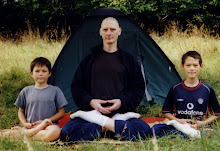Master Dogen wrote, in Shobogenzo chapter 4, Ikka no Myoju, The One Bright Pearl:
"Do not worry about falling or not falling into the six states of cause and effect. They are the original state of being right from head to tail, which is never unclear, and the bright pearl is its features and the bright pearl is its eyes."
"The six states of cause and effect" is originally ROKUDO NO INGA. INGA means cause and effect. ROKU means six. DO means ways, states, worlds, realms. ROKUDO NO INGA expresses the experience that, our karma being as it is, in our everyday life we seem to transmigrate endlessly through a cyclical succession of states -- traditionally enumerated as hell, followed by the realms of hungry ghosts, animals, asuras, human beings and gods.
When I was discussing my understanding of this teaching recently with an old friend in sitting-zen, he made a remark along the lines of: "Mike, you are not saying anything new. People long ago made the connection between the six realms and psychological states."
Now, maybe I am wrong on this. Maybe I protest too much. Maybe James Cohen, in his wisdom and compassion, is correct in his internet diagnosis of me (never having met me face to face)and his resulting proposal that I should be reconsidered for re-admission into Dogen Sangha only after completing a course of psychological counselling under a qualified professional. Maybe I am wrong, but I do not see the transmigration through the six samsaric realms, which I have been experiencing now for more than 25 years from the vantage point of sitting in lotus four times a day, as primarily a psychological problem. Neither do I sit this transmigration as primarily a problem of imbalance of the autonomic nervous system -- although comparing the insight of psychologists such as Cohen and the like, with Gudo's insight into the primacy in sitting-zen of the physical body, might be like comparing the light of a firefly and the brightness of a full mooon.
What I am proposing is that the six samsaric realms are primarily neither psychological nor autonomic states, but primarily vestibular states. I am talking on the basis of what Master Nagarjuna called pratitya-samutpada, grounded arising -- rising from real grounds. Rising from the ground, in the case of every real human being from Sakyamuni on down and back up again, has invariably been primarily a vestibular problem.
Friday, 29 February 2008
Subscribe to:
Post Comments (Atom)

2 comments:
Hi Will,
I also have been thinking about the proper order.
On the basis of the hierarchical development of the primitive and postural reflexes, ATNR definitely preceedes STNR, in which case asura precedes animals, thus:
FPR vs MORO (hell) --> TLR/ATNR (ghost/asura) --> STNR (monkeys) --> postural reflexes (humans) --> over-excited top two inches (deva).
But if the category of animals is extended back to include less evolved creatures than STNR-exhibiting monkeys, e.g. fish and reptiles, then there is a case for listing animals before asura.
At time of writing I am not exactly sure how high I am up the food chain, but it is nearly time for my morning porridge, and I must confess I could just fancy a banana in it.
Post a Comment